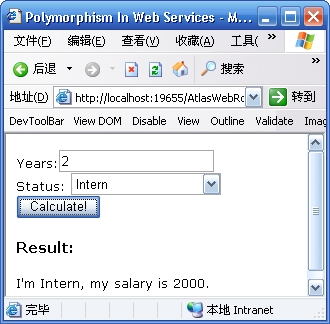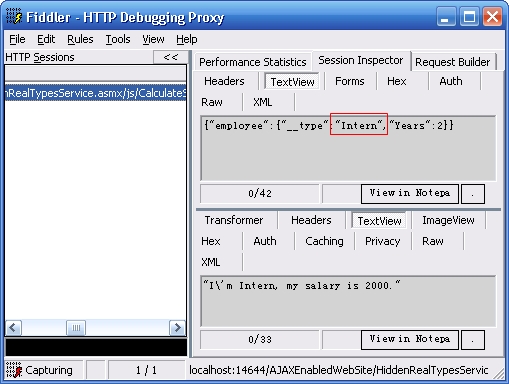1、定义需要的类型
首先,我们定义一下所需的类型。我们的目标是计算某种类型员工的工资,于是,我们先定义一个员工的抽象类:
namespace
Jeffz.HiddenTypes
{
public abstract class Employee
{
private int _Years;
public int Years
{
get
{
return this ._Years;
}
set
{
this ._Years = value;
}
}
public string RealStatus
{
get
{
return this .GetType().Name;
}
}
public abstract int CalculateSalary();
}
}
{
public abstract class Employee
{
private int _Years;
public int Years
{
get
{
return this ._Years;
}
set
{
this ._Years = value;
}
}
public string RealStatus
{
get
{
return this .GetType().Name;
}
}
public abstract int CalculateSalary();
}
}
然后定义一下可怜的实习生,不管干多少年,永远只有2000元工资:
namespace
Jeffz.HiddenTypes
{
public class Intern : Employee
{
public override int CalculateSalary()
{
return 2000 ;
}
}
}
{
public class Intern : Employee
{
public override int CalculateSalary()
{
return 2000 ;
}
}
}
然后是签第三方公司的合同工,底薪5000,每年增加1000:
namespace
Jeffz.HiddenTypes
{
public class Vendor : Employee
{
public override int CalculateSalary()
{
return 5000 + 1000 * (Years - 1 );
}
}
}
{
public class Vendor : Employee
{
public override int CalculateSalary()
{
return 5000 + 1000 * (Years - 1 );
}
}
}
最后是正式员工(全职工),底薪12000,每年增加2000:
namespace
Jeffz.HiddenTypes
{
public class FulltimeEmployee : Employee
{
public override int CalculateSalary()
{
return 12000 + 2000 * (Years - 1 );
}
}
}
{
public class FulltimeEmployee : Employee
{
public override int CalculateSalary()
{
return 12000 + 2000 * (Years - 1 );
}
}
}
2、制作一个不隐藏服务器端类型的应用
首先,自然是定义一个Web Service,我们将其命名为ExposedRealTypesService.asmx
[WebService(Namespace
=
"
http://tempuri.org/
"
)]
[WebServiceBinding(ConformsTo = WsiProfiles.BasicProfile1_1)]
[ScriptService]
public class ExposedRealTypesService : System.Web.Services.WebService
{
[GenerateScriptType( typeof (Intern))]
[GenerateScriptType( typeof (Vendor))]
[GenerateScriptType( typeof (FulltimeEmployee))]
[WebMethod]
public string CalculateSalary(Employee employee)
{
return " I'm " + employee.RealStatus + " , my salary is " + employee.CalculateSalary() + " . " ;
}
}
[WebServiceBinding(ConformsTo = WsiProfiles.BasicProfile1_1)]
[ScriptService]
public class ExposedRealTypesService : System.Web.Services.WebService
{
[GenerateScriptType( typeof (Intern))]
[GenerateScriptType( typeof (Vendor))]
[GenerateScriptType( typeof (FulltimeEmployee))]
[WebMethod]
public string CalculateSalary(Employee employee)
{
return " I'm " + employee.RealStatus + " , my salary is " + employee.CalculateSalary() + " . " ;
}
}
在这里我们使用了GenerateScriptTypeAttribute来告诉这个Web Service:“我们可能会使用这些类来作为参数传递给你,请注意JSON字符串里的__type标志”,于是我们就能使用了。我们来看一下我们需要的HTML:
<
asp:ScriptManager
ID
="ScriptManager"
runat
="server"
>
< Services >
< asp:ServiceReference Path ="ExposedRealTypesService.asmx" InlineScript ="false" />
</ Services >
</ asp:ScriptManager >
< div > Years: < input type ="text" id ="txtYears" /></ div >
< div >
Status:
< select id ="comboStatus" style ="width:150px;" >
< option value ="Jeffz.HiddenTypes.Intern" > Intern </ option >
< option value ="Jeffz.HiddenTypes.Vendor" > Vendor </ option >
< option value ="Jeffz.HiddenTypes.FulltimeEmployee" > FTE </ option >
</ select >
</ div >
< input type ="button" onclick ="calculateSalary()" value ="Calculate!" />
< h1 > Result: </ h1 >
< div id ="result" ></ div >
< Services >
< asp:ServiceReference Path ="ExposedRealTypesService.asmx" InlineScript ="false" />
</ Services >
</ asp:ScriptManager >
< div > Years: < input type ="text" id ="txtYears" /></ div >
< div >
Status:
< select id ="comboStatus" style ="width:150px;" >
< option value ="Jeffz.HiddenTypes.Intern" > Intern </ option >
< option value ="Jeffz.HiddenTypes.Vendor" > Vendor </ option >
< option value ="Jeffz.HiddenTypes.FulltimeEmployee" > FTE </ option >
</ select >
</ div >
< input type ="button" onclick ="calculateSalary()" value ="Calculate!" />
< h1 > Result: </ h1 >
< div id ="result" ></ div >
所需的JavaScript代码如下:
function
calculateSalary()
{
var emp = eval( " new " + $get( " comboStatus " ).value + " () " );
emp.Years = parseInt($get( " txtYears " ).value, 10 );
ExposedRealTypesService.CalculateSalary(emp, onComplete);
}
function onComplete(result)
{
$get( " result " ).innerHTML = result;
}
{
var emp = eval( " new " + $get( " comboStatus " ).value + " () " );
emp.Years = parseInt($get( " txtYears " ).value, 10 );
ExposedRealTypesService.CalculateSalary(emp, onComplete);
}
function onComplete(result)
{
$get( " result " ).innerHTML = result;
}
由于comboStatue的value就是客户端的类名,因此我使用了拼接字符串并且eval的方法生成客户端的类,并作为参数传递过去。其余的代码应该非常简单,我们就来看一下使用效果吧:
打开页面,先选择Intern,输入工龄为2,点击“Calculate!”按钮:

再选择FTE,输入工龄为5,点击“Calculate!”按钮:

嘿,这说明我们客户端传了不同的服务器对象给Web Service方法了。
3、隐藏客户端的__type信息
我们打开Fiddler看看请求的内容吧:

嗯?看到了JSON字符串里的信息了不?明明白白地写着“Jeffz.HiddenTypes.Intern”!哎,怎么能把我们服务器端的类型信息给暴露出去呢?这样是不是太危险了一点?不过没有关系,我们可以这么做。首先,修改一下Web Service方法,我们这里就另存为HiddenRealTypesService.asmx吧:
[WebService(Namespace = "http://tempuri.org/")]
[WebServiceBinding(ConformsTo = WsiProfiles.BasicProfile1_1)]
[ScriptService]
public class HiddenRealTypesService : System.Web.Services.WebService
{
[GenerateScriptType(typeof(Intern), ScriptTypeId="Intern")]
[GenerateScriptType(typeof(Vendor), ScriptTypeId = "Vendor")]
[GenerateScriptType(typeof(FulltimeEmployee), ScriptTypeId = "FTE")]
[WebMethod]
public string CalculateSalary(Employee employee)
{
return "I'm " + employee.RealStatus + ", my salary is " + employee.CalculateSalary() + ".";
}
}
[WebServiceBinding(ConformsTo = WsiProfiles.BasicProfile1_1)]
[ScriptService]
public class HiddenRealTypesService : System.Web.Services.WebService
{
[GenerateScriptType(typeof(Intern), ScriptTypeId="Intern")]
[GenerateScriptType(typeof(Vendor), ScriptTypeId = "Vendor")]
[GenerateScriptType(typeof(FulltimeEmployee), ScriptTypeId = "FTE")]
[WebMethod]
public string CalculateSalary(Employee employee)
{
return "I'm " + employee.RealStatus + ", my salary is " + employee.CalculateSalary() + ".";
}
}
注意到了在使用GenerateScriptTypeAttribute时我们改变了什么吗?对了,就是我们设置了“ScriptTypeId”的值。这是什么?我们来看一下GenerateScriptTypeAttribute的使用方式吧。如下:
internal
class
WebServiceData : JavaScriptTypeResolver
{
……
private void ProcessIncludeAttributes(GenerateScriptTypeAttribute[] attributes)
{
foreach (GenerateScriptTypeAttribute attribute1 in attributes)
{
if ( ! string .IsNullOrEmpty(attribute1.ScriptTypeId))
{
this ._typeResolverSpecials[attribute1.Type.FullName] = attribute1.ScriptTypeId;
}
……
this .ProcessClientType(type1);
}
}
……
}
{
……
private void ProcessIncludeAttributes(GenerateScriptTypeAttribute[] attributes)
{
foreach (GenerateScriptTypeAttribute attribute1 in attributes)
{
if ( ! string .IsNullOrEmpty(attribute1.ScriptTypeId))
{
this ._typeResolverSpecials[attribute1.Type.FullName] = attribute1.ScriptTypeId;
}
……
this .ProcessClientType(type1);
}
}
……
}
这段代码就是ASP.NET AJAX用于处理Web Service的WebServiceData类,当然它也提供了许多功能。在ProcessIncludeAttributes方法中会处理所有的GenrateScriptTypeAttribute,可以看到在这里为每个Attribute的ScriptTypeId与Type的FullName进行了映射。这种映射是不是让你想到了JavaScriptTypeResovler?没错,WebServiceData类就是继承了JavaScriptTypeResolver,它辅助了ASP.NET AJAX客户端访问Web Service方法时的序列化与反序列化工作。关于这一点,在我之前的文章《 深入Atlas系列:探究序列化与反序列化能力(上) - 客户端支持,JavaScriptTypeResolver与JavaScriptConverter》里有比较详细的描述。
我们来看一下效果,当然在这之前还需要修改一下页面中ScriptManager的Service引用,如下:
<
asp:ScriptManager
ID
="ScriptManager"
runat
="server"
>
< Services >
< asp:ServiceReference Path ="HiddenRealTypesService.asmx" />
</ Services >
</ asp:ScriptManager >
< Services >
< asp:ServiceReference Path ="HiddenRealTypesService.asmx" />
</ Services >
</ asp:ScriptManager >
再用Fiddler看一下传输内容吧,如下:

嘿,这样就不会把服务器端的具体类型暴露给别人了,不是吗?嗯,我们再多想想……:)
4、隐藏客户端代码调用时使用的具体信息
我们还有相当的路要走。有没有发现,我们在调用中带有了非常“明显”的类型信息。我们的方式其实和下面的差不多:
var
emp
=
new
Jeffz.HiddenTypes.Intern();
……
HiddenRealTypesService.CalculateSalary(emp, onComplete);
……
HiddenRealTypesService.CalculateSalary(emp, onComplete);
“Jeffz.HiddenTypes.Intern”?这不还是服务器端的具体类型吗?那么该怎么办呢?其实“new Jeffz.HiddenTypes.Intern()”操作也只是返回了一个普通的Object对象,不过它带有“__type”这个信息,其值为服务器端具体类型的ID。因此我们其实只要像下面这么做,也能得到同样的效果了。
首先,将<select />元素改成如下的形式:
<
select
id
="comboStatus"
style
="width:150px;"
>
< option value ="Intern" > Intern </ option >
< option value ="Vendor" > Vendor </ option >
< option value ="FTE" > FTE </ option >
</ select >
< option value ="Intern" > Intern </ option >
< option value ="Vendor" > Vendor </ option >
< option value ="FTE" > FTE </ option >
</ select >
这样就不会暴露出服务器端的具体类型了。然后我们相应地修改JavaScript代码,如下:
function
calculateSalary()
{
var emp = { '__type' : $get( "comboStatus" ).value };
emp.Years = parseInt($get( " txtYears " ).value, 10 );
HiddenRealTypesService.CalculateSalary(emp, onComplete);
}
{
var emp = { '__type' : $get( "comboStatus" ).value };
emp.Years = parseInt($get( " txtYears " ).value, 10 );
HiddenRealTypesService.CalculateSalary(emp, onComplete);
}
再使用一下代码,一切正常,我们需要知道的只是服务器端具体类型的ID。这下完美了吧!再等等,再想想……
5、取消使用Service代理
我们还使用了ASP.NET AJAX为Web Service生成的代理,我们服务器端具体类型的信息都在那里,这不行,赶快取消!当然,在取消的同时不能破坏了Web Service方法的正常使用。我们该怎么做呢?
事实上,Web Service代理是通过访问XXXXX.asmx/js(Release模式)或者XXXXX.asmx/jsdebug输出的。我们必须禁止它。在这里我选择的方式是在Global.asax提供Application_BeginRequest的定义,它会在请求的一开始被调用。代码如下:
void
Application_BeginRequest(
object
sender, EventArgs e)
{
string pathInfo = this .Context.Request.PathInfo;
if ( " /js " .Equals(pathInfo, StringComparison.OrdinalIgnoreCase) ||
" /jsdebug " .Equals(pathInfo, StringComparison.OrdinalIgnoreCase))
{
throw new InvalidOperationException( " You can't get the proxy script! " );
}
}
{
string pathInfo = this .Context.Request.PathInfo;
if ( " /js " .Equals(pathInfo, StringComparison.OrdinalIgnoreCase) ||
" /jsdebug " .Equals(pathInfo, StringComparison.OrdinalIgnoreCase))
{
throw new InvalidOperationException( " You can't get the proxy script! " );
}
}
我们判断了请求地址的PathInfo,如果为“/js”或者“/jsdebug”时,则抛出异常,这样就禁止获得了任何的Web Service的Proxy信息,当然您也可以有选择地禁掉部分而不是全部。
哎,这样我们不就不能使用Web Service的Proxy了吗?没错,所以我们还必须修改一下JavaScript代码,使用一种相对“原始”的方式访问Web Service方法。如下:
var
proxy
=
{
_get_path : function (){ return " HiddenRealTypesService.asmx " },
get_defaultFailedCallback : function (){},
get_defaultUserContext : function (){},
get_timeout : function (){ return 0 ; /* unlimited */ }
};
function calculateSalary()
{
var emp = { '__type' : $get( " comboStatus " ).value };
emp.Years = parseInt($get( " txtYears " ).value, 10 );
Sys.Net._WebMethod._invoke(
proxy, // proxy
" CalculateSalary " , // method name for calling
" CalculateSalary " , // method name for showing
false , // do not use HTTP GET
{ employee : emp }, // parameters
onComplete // onSuccess
);
}
_get_path : function (){ return " HiddenRealTypesService.asmx " },
get_defaultFailedCallback : function (){},
get_defaultUserContext : function (){},
get_timeout : function (){ return 0 ; /* unlimited */ }
};
function calculateSalary()
{
var emp = { '__type' : $get( " comboStatus " ).value };
emp.Years = parseInt($get( " txtYears " ).value, 10 );
Sys.Net._WebMethod._invoke(
proxy, // proxy
" CalculateSalary " , // method name for calling
" CalculateSalary " , // method name for showing
false , // do not use HTTP GET
{ employee : emp }, // parameters
onComplete // onSuccess
);
}
这里定义了一个Proxy,这是使用Sys.Net._WebMethod所必须的。上面代码的原理,在我以前的文章《 深入Atlas系列:Web Sevices Access in Atlas(7) - RTM中的客户端支持》有比较详细的分析。
到现在,我们终于完全隐藏了服务器端的类型信息,不过这是靠编写更多的代码而换来的(不过似乎还算好)。孰优孰劣,孰轻孰重,就只能请大家自己判断了。:)
点击这里下载代码。























 8925
8925

 被折叠的 条评论
为什么被折叠?
被折叠的 条评论
为什么被折叠?








